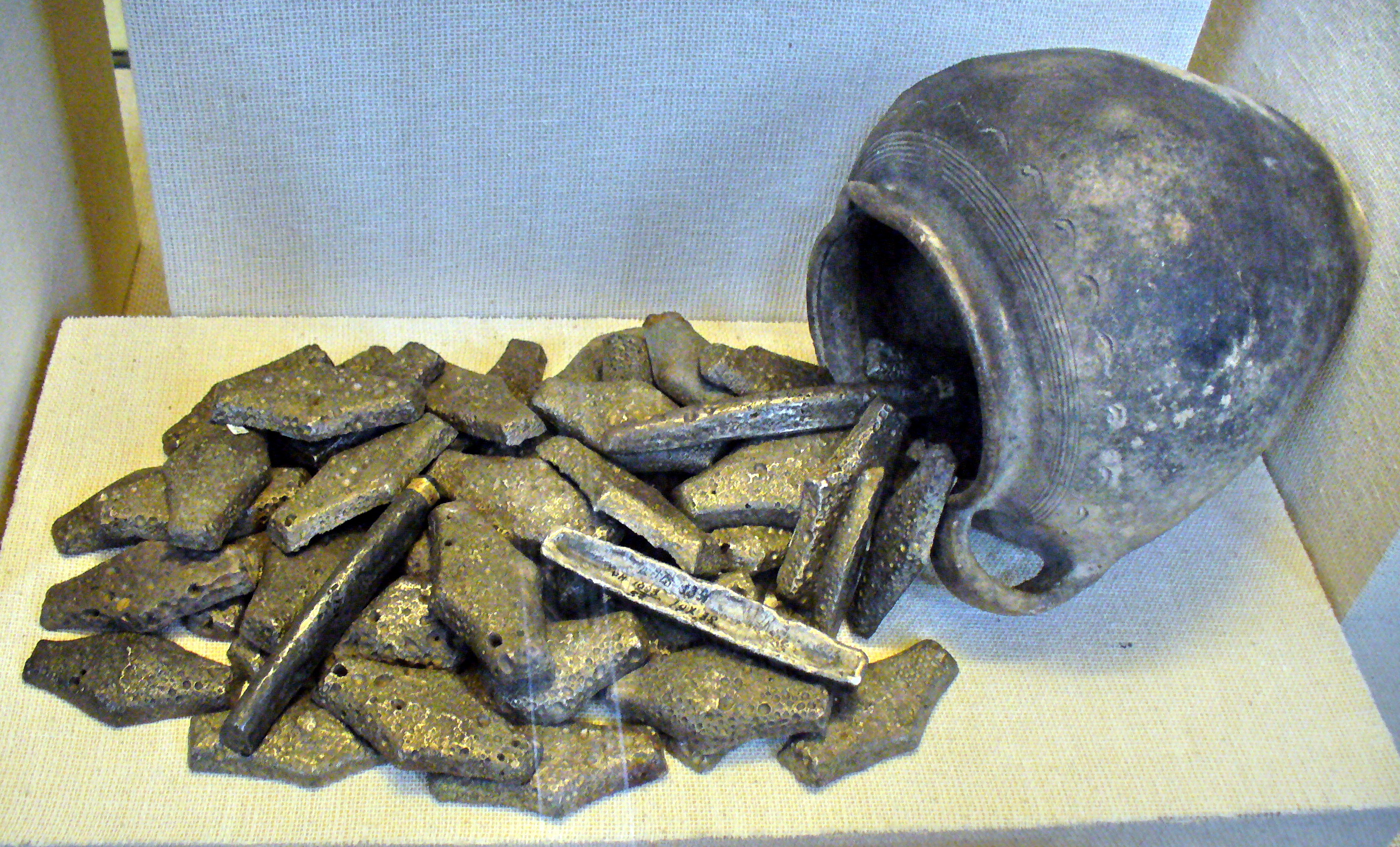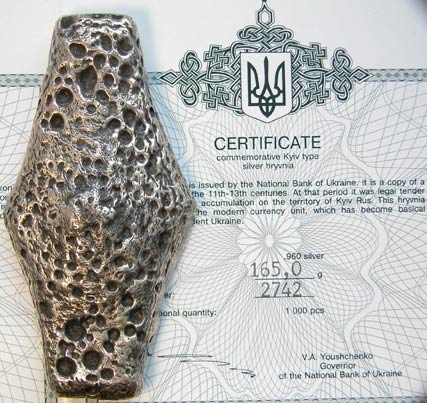|
Grivna
Grivna (гривна) was a currency as well as a measure of weight used in Kievan Rus' and other East Slavic countries since the 11th century. Name The word ''grivna'' is derived from from . In Old East Slavic it had the form ''grivĭna''. In modern East Slavic languages it has such forms: russian: гри́вна ''grivna'', uk, гри́вня ''hryvnia'', be, гры́ўня ''hryŭnia''. The name of the contemporary currency of Ukraine, '' hryvnia'', is derived from the ancient grivna. History Early period As its etymology implies the word originally meant a necklace or a torque. The reason why it has taken the meaning of a unit of weight is unclear. The grivnas that have been found at various archaeological sites are not necklaces but bullions of precious metals, usually silver. The weight and the shape of grivnas were not uniform, but varied by region. The grivnas of Novgorod and Pskov were thin long round-edged or three-edged ingots, while Kievan grivnas h ... [...More Info...] [...Related Items...] OR: [Wikipedia] [Google] [Baidu] |
Hryvnia
The or ( ; uk, гривня , : ''hrn''; sign: ₴; code: UAH) has been the national currency of Ukraine since 2 September 1996. The hryvnia is divided into 100 . It is named after a measure of weight used in medieval Kievan Rus'. Name Etymology The currency of Kievan Rus' in the eleventh century was called ''grivna''. The word is thought to derive from the Slavic ''griva''; c.f. Ukrainian, Russian, Bulgarian, and Serbo-Croatian / ''griva'', meaning "mane". It might have indicated something valuable worn around the neck, usually made of silver or gold; c.f. Bulgarian and Serbian ''grivna'' (, "bracelet"). Later, the word was used to describe silver or gold ingots of a certain weight; c.f. Ukrainian ''hryvenyk'' (). Plural The nominative plural of hryvnia is ''hryvni'' ( uk, гривні), while the genitive plural is ''hryven’'' ( uk, гривень). In Ukrainian, the nominative plural form is used for numbers ending with 2, 3, or 4, as in ''dvi hryvni'' (дві гр� ... [...More Info...] [...Related Items...] OR: [Wikipedia] [Google] [Baidu] |
History Of Ukrainian Hryvnia
The history of the Ukrainian hryvnia refers to the more than 1200 years of history since the princes of Kievan Rus' established silver ingots called hryvnias as a mean of money and a measure of weight. The hryvnia has been the national currency of Ukraine since 1996. Etymology The word “''hryvnia''” in Kievan Rus' first meant a decoration worn at the nape of the neck, which often served as a measure of weight at the time. The first mention of "hryvnia" in the meaning of currency is found in "The Tale of Bygone Years" between 8th and 9th centuries. The chronicle relates that Prince Oleg the Prophet, coming from the North, began to rule in Kyiv and "established to give the Vikings from Novgorod three hundred hryvnias a year, for peace," indicating that in the hryvnia was used as a measure of weight and counting from the 8th to 9th centuries when conducting trade operations or paying tribute. In the 11th century, the word "hryvnia" began to be used to refer to weight, with ... [...More Info...] [...Related Items...] OR: [Wikipedia] [Google] [Baidu] |
Kievan Rus'
Kievan Rusʹ, also known as Kyivan Rusʹ ( orv, , Rusĭ, or , , ; Old Norse: ''Garðaríki''), was a state in Eastern and Northern Europe from the late 9th to the mid-13th century.John Channon & Robert Hudson, ''Penguin Historical Atlas of Russia'' (Penguin, 1995), p.14–16.Kievan Rus Encyclopædia Britannica Online. Encompassing a variety of polities and peoples, including East Slavic, , and Finnic, it was ruled by the Rurik dynasty< ... [...More Info...] [...Related Items...] OR: [Wikipedia] [Google] [Baidu] |
Manilla (money)
Manillas are a form of commodity money, usually made of bronze or copper, which were used in West Africa.Chamberlain, C. C.(1963). The Teach Yourself ''Guide to Numismatics''. English Universities Press. p. 92. They were produced in large numbers in a wide range of designs, sizes, and weights. Originating before the colonial period, perhaps as the result of trade with the Portuguese Empire, Manillas continued to serve as money and decorative objects until the late 1940s and are still sometimes used as decoration. In popular culture, they are particularly associated with the Atlantic slave trade. Origins and etymology The name ''manilla'' is said to derive from the Spanish language, Spanish for a 'bracelet' , the Portuguese language, Portuguese for 'hand-ring' ,Rees, Alun (2000). ''Manillas.'' Coin News. April 2000. ISSN 0958-1391. p. 46–47. or after the Latin (hand) or from , plural of (necklace). They are usually horseshoe-shaped, with terminations that face each other and a ... [...More Info...] [...Related Items...] OR: [Wikipedia] [Google] [Baidu] |
Marten
A marten is a weasel-like mammal in the genus ''Martes'' within the subfamily Guloninae, in the family Mustelidae. They have bushy tails and large paws with partially retractile claws. The fur varies from yellowish to dark brown, depending on the species; it is valued by animal trappers for the fur trade. Martens are slender, agile animals, adapted to living in the taiga, which inhabit coniferous and northern deciduous forests across the Northern Hemisphere. Classification Results of DNA research indicate that the genus ''Martes'' is paraphyletic, with some studies placing ''Martes americana'' outside the genus and allying it with '' Eira'' and '' Gulo'', to form a new New World clade. The genus first evolved up to seven million years ago during the Miocene epoch. Fossils Several fossil martens have been described, including: *†''Martes campestris'' (Pliocene) *†''Martes wenzensis'' (Pliocene) *†''Martes vetus'' (Pleistocene) Another described fossil species, ''Ma ... [...More Info...] [...Related Items...] OR: [Wikipedia] [Google] [Baidu] |
|




